ATMC ICT310 System Analysis and Design Report - Semester 2, 2019
VerifiedAdded on 2022/09/17
|15
|2785
|34
Report
AI Summary
This report provides a comprehensive analysis of system analysis and design, focusing on the System Development Life Cycle (SDLC) and Agile methodology. It details the core processes and activities within the SDLC, including problem identification, planning, understanding details, system design, build/test/integrate, and system testing. The report also explores the Agile methodology, highlighting its application in the context of a 'Controller Project' for Your IT Support Crowd Pty Ltd. Furthermore, the report includes an event table, a use case diagram, and a detailed use case description for creating an offsite backup task. Finally, it presents a domain model class diagram and a design class diagram, offering a visual representation of the system's structure and components. The document is a solution to the ICT310 System Analysis and Design assignment, Task 2, for ATMC, Semester 2, 2019.

Running head: ICT310 SYSTEM ANALYSIS AND DESIGN
ICT310 SYSTEM ANALYSIS AND DESIGN
Name of student
Name of university
Author’s note:
ICT310 SYSTEM ANALYSIS AND DESIGN
Name of student
Name of university
Author’s note:
Paraphrase This Document
Need a fresh take? Get an instant paraphrase of this document with our AI Paraphraser
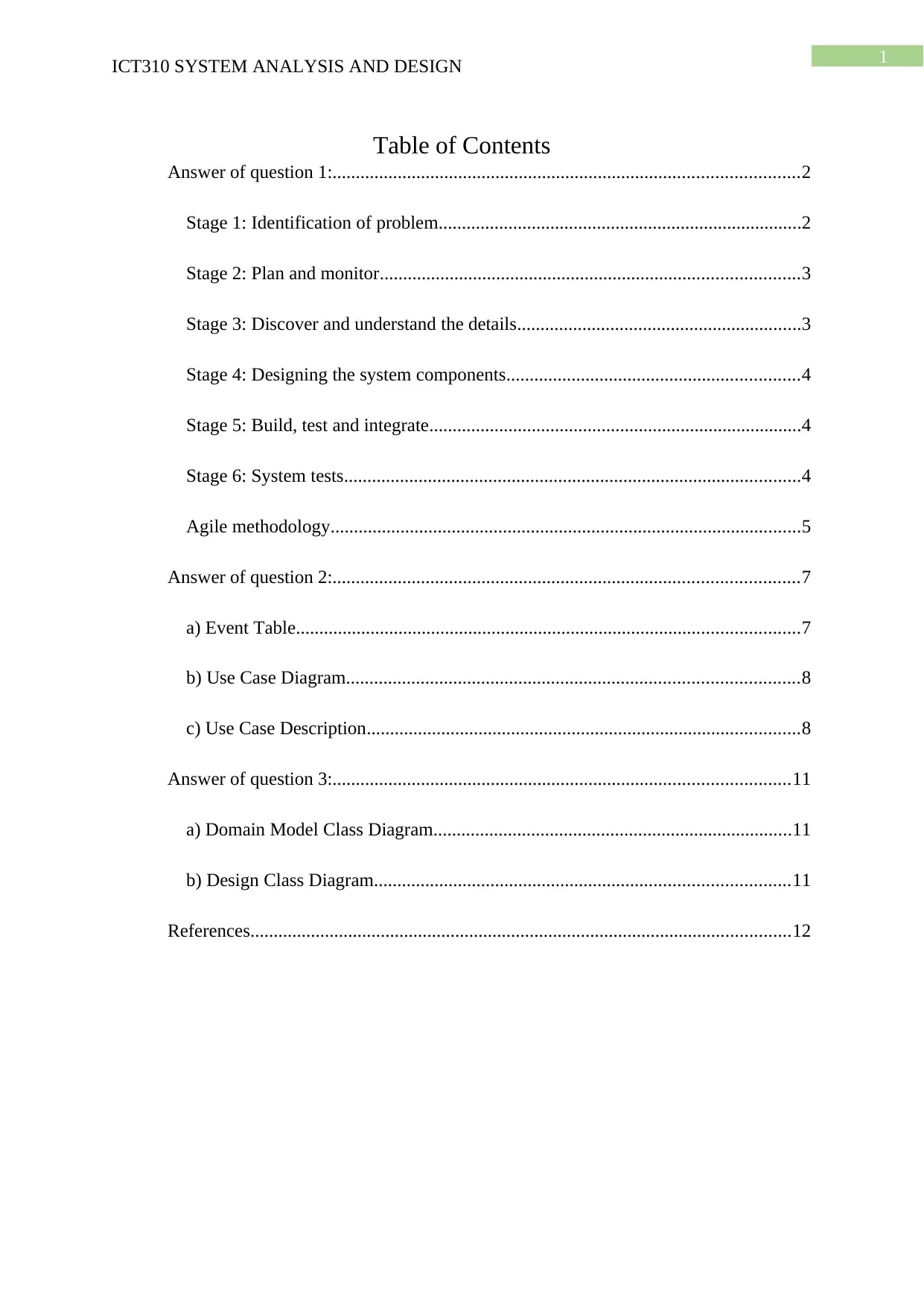
1
ICT310 SYSTEM ANALYSIS AND DESIGN
Table of Contents
Answer of question 1:....................................................................................................2
Stage 1: Identification of problem..............................................................................2
Stage 2: Plan and monitor..........................................................................................3
Stage 3: Discover and understand the details.............................................................3
Stage 4: Designing the system components...............................................................4
Stage 5: Build, test and integrate................................................................................4
Stage 6: System tests..................................................................................................4
Agile methodology.....................................................................................................5
Answer of question 2:....................................................................................................7
a) Event Table............................................................................................................7
b) Use Case Diagram.................................................................................................8
c) Use Case Description.............................................................................................8
Answer of question 3:..................................................................................................11
a) Domain Model Class Diagram.............................................................................11
b) Design Class Diagram.........................................................................................11
References....................................................................................................................12
ICT310 SYSTEM ANALYSIS AND DESIGN
Table of Contents
Answer of question 1:....................................................................................................2
Stage 1: Identification of problem..............................................................................2
Stage 2: Plan and monitor..........................................................................................3
Stage 3: Discover and understand the details.............................................................3
Stage 4: Designing the system components...............................................................4
Stage 5: Build, test and integrate................................................................................4
Stage 6: System tests..................................................................................................4
Agile methodology.....................................................................................................5
Answer of question 2:....................................................................................................7
a) Event Table............................................................................................................7
b) Use Case Diagram.................................................................................................8
c) Use Case Description.............................................................................................8
Answer of question 3:..................................................................................................11
a) Domain Model Class Diagram.............................................................................11
b) Design Class Diagram.........................................................................................11
References....................................................................................................................12
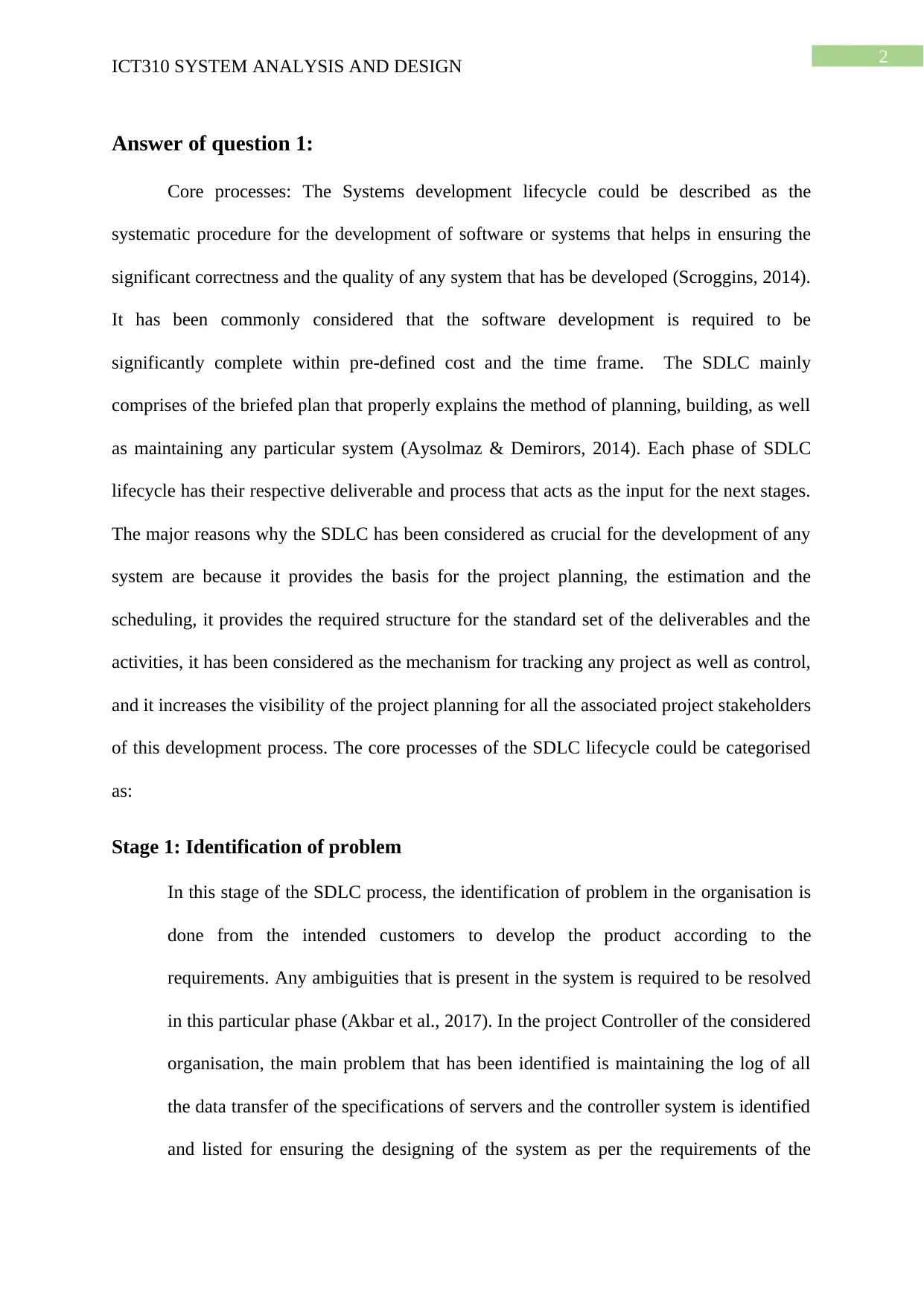
2
ICT310 SYSTEM ANALYSIS AND DESIGN
Answer of question 1:
Core processes: The Systems development lifecycle could be described as the
systematic procedure for the development of software or systems that helps in ensuring the
significant correctness and the quality of any system that has be developed (Scroggins, 2014).
It has been commonly considered that the software development is required to be
significantly complete within pre-defined cost and the time frame. The SDLC mainly
comprises of the briefed plan that properly explains the method of planning, building, as well
as maintaining any particular system (Aysolmaz & Demirors, 2014). Each phase of SDLC
lifecycle has their respective deliverable and process that acts as the input for the next stages.
The major reasons why the SDLC has been considered as crucial for the development of any
system are because it provides the basis for the project planning, the estimation and the
scheduling, it provides the required structure for the standard set of the deliverables and the
activities, it has been considered as the mechanism for tracking any project as well as control,
and it increases the visibility of the project planning for all the associated project stakeholders
of this development process. The core processes of the SDLC lifecycle could be categorised
as:
Stage 1: Identification of problem
In this stage of the SDLC process, the identification of problem in the organisation is
done from the intended customers to develop the product according to the
requirements. Any ambiguities that is present in the system is required to be resolved
in this particular phase (Akbar et al., 2017). In the project Controller of the considered
organisation, the main problem that has been identified is maintaining the log of all
the data transfer of the specifications of servers and the controller system is identified
and listed for ensuring the designing of the system as per the requirements of the
ICT310 SYSTEM ANALYSIS AND DESIGN
Answer of question 1:
Core processes: The Systems development lifecycle could be described as the
systematic procedure for the development of software or systems that helps in ensuring the
significant correctness and the quality of any system that has be developed (Scroggins, 2014).
It has been commonly considered that the software development is required to be
significantly complete within pre-defined cost and the time frame. The SDLC mainly
comprises of the briefed plan that properly explains the method of planning, building, as well
as maintaining any particular system (Aysolmaz & Demirors, 2014). Each phase of SDLC
lifecycle has their respective deliverable and process that acts as the input for the next stages.
The major reasons why the SDLC has been considered as crucial for the development of any
system are because it provides the basis for the project planning, the estimation and the
scheduling, it provides the required structure for the standard set of the deliverables and the
activities, it has been considered as the mechanism for tracking any project as well as control,
and it increases the visibility of the project planning for all the associated project stakeholders
of this development process. The core processes of the SDLC lifecycle could be categorised
as:
Stage 1: Identification of problem
In this stage of the SDLC process, the identification of problem in the organisation is
done from the intended customers to develop the product according to the
requirements. Any ambiguities that is present in the system is required to be resolved
in this particular phase (Akbar et al., 2017). In the project Controller of the considered
organisation, the main problem that has been identified is maintaining the log of all
the data transfer of the specifications of servers and the controller system is identified
and listed for ensuring the designing of the system as per the requirements of the
⊘ This is a preview!⊘
Do you want full access?
Subscribe today to unlock all pages.

Trusted by 1+ million students worldwide

3
ICT310 SYSTEM ANALYSIS AND DESIGN
organisation. As soon as the requirement collection has been done, an analysis is
conducted for checking the feasibility of any development of product. Controller
system is being developed in this project that would manage the logs of transfer of
backup data between server and client. Project plan is created for the Controller
project that would specify the details of this project.
Stage 2: Plan and monitor
Within this phase, all the requirement that has been collected in the phase of
requirement gathering could be used as the input and the software architecture that
has been used for the implementation of the system development is mainly derived
(Dora & Dubey, 2015). In the considered case study of the organisation, the software
requirements of the controller, server and the client is analysed and an appropriate
design is presented for analysis. The infrastructure of the organisation after the
implementation of Controller system is analysed. The most appropriate servers and
clients are recommended for avoiding any kind of crash or malfunction of the
controller system.
Stage 3: Discover and understand the details
This phase mainly includes the discovery of the details of the project and understand
the main components that requires additional attention. The components of the
controller project is understood and then the details of the components is clearly
comprehended (Kotaiah & Khalil, 2017). The software design has been translated into
the source code and all the designing of the system is initiated. In the situation of the
Your IT Support Crowd Pty Ltd, the designing of the Controller system is initiated
when the requirements are analysed. The database for the controller application is
developed in this phase where the logs of transfer among the server and client would
ICT310 SYSTEM ANALYSIS AND DESIGN
organisation. As soon as the requirement collection has been done, an analysis is
conducted for checking the feasibility of any development of product. Controller
system is being developed in this project that would manage the logs of transfer of
backup data between server and client. Project plan is created for the Controller
project that would specify the details of this project.
Stage 2: Plan and monitor
Within this phase, all the requirement that has been collected in the phase of
requirement gathering could be used as the input and the software architecture that
has been used for the implementation of the system development is mainly derived
(Dora & Dubey, 2015). In the considered case study of the organisation, the software
requirements of the controller, server and the client is analysed and an appropriate
design is presented for analysis. The infrastructure of the organisation after the
implementation of Controller system is analysed. The most appropriate servers and
clients are recommended for avoiding any kind of crash or malfunction of the
controller system.
Stage 3: Discover and understand the details
This phase mainly includes the discovery of the details of the project and understand
the main components that requires additional attention. The components of the
controller project is understood and then the details of the components is clearly
comprehended (Kotaiah & Khalil, 2017). The software design has been translated into
the source code and all the designing of the system is initiated. In the situation of the
Your IT Support Crowd Pty Ltd, the designing of the Controller system is initiated
when the requirements are analysed. The database for the controller application is
developed in this phase where the logs of transfer among the server and client would
Paraphrase This Document
Need a fresh take? Get an instant paraphrase of this document with our AI Paraphraser
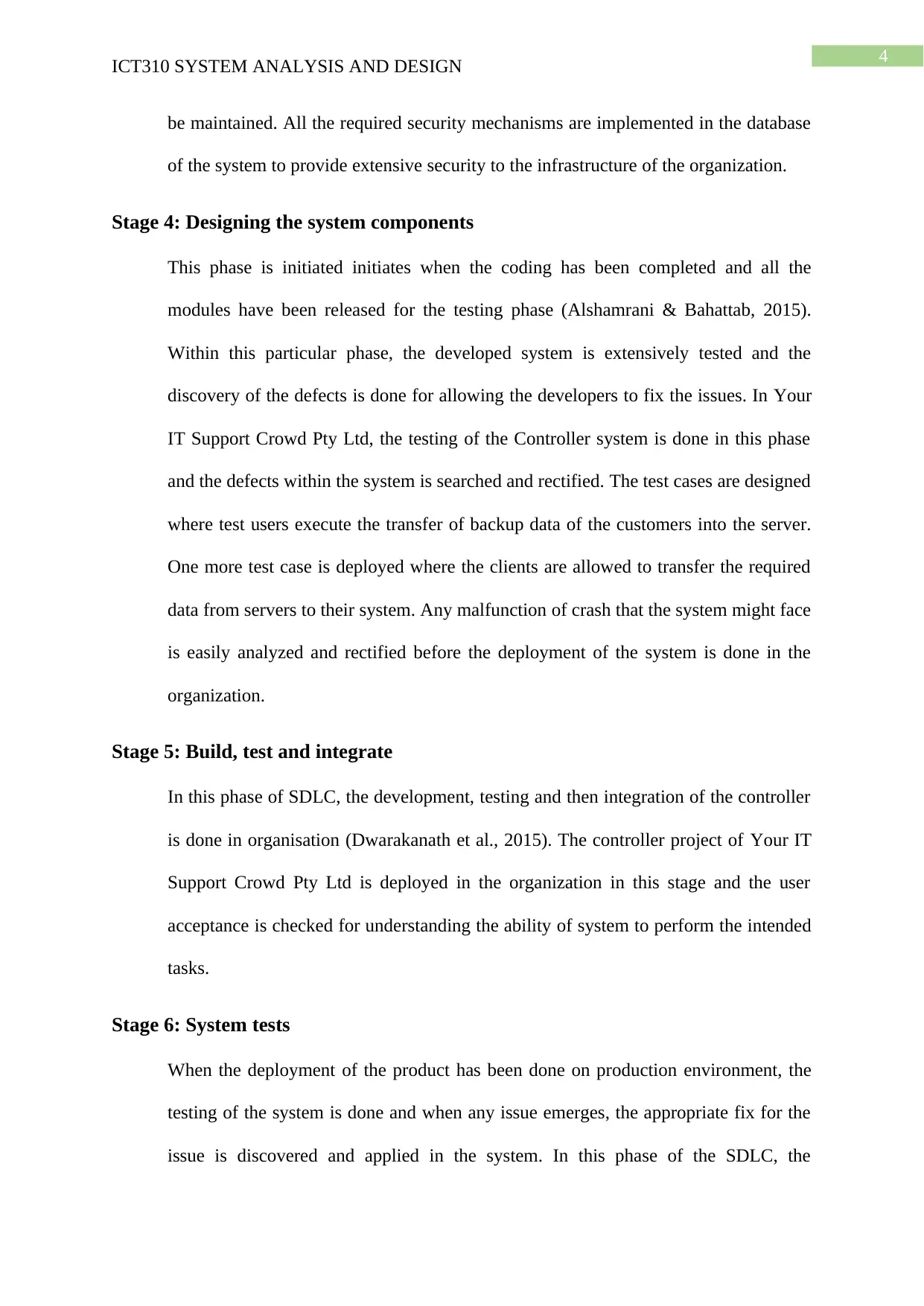
4
ICT310 SYSTEM ANALYSIS AND DESIGN
be maintained. All the required security mechanisms are implemented in the database
of the system to provide extensive security to the infrastructure of the organization.
Stage 4: Designing the system components
This phase is initiated initiates when the coding has been completed and all the
modules have been released for the testing phase (Alshamrani & Bahattab, 2015).
Within this particular phase, the developed system is extensively tested and the
discovery of the defects is done for allowing the developers to fix the issues. In Your
IT Support Crowd Pty Ltd, the testing of the Controller system is done in this phase
and the defects within the system is searched and rectified. The test cases are designed
where test users execute the transfer of backup data of the customers into the server.
One more test case is deployed where the clients are allowed to transfer the required
data from servers to their system. Any malfunction of crash that the system might face
is easily analyzed and rectified before the deployment of the system is done in the
organization.
Stage 5: Build, test and integrate
In this phase of SDLC, the development, testing and then integration of the controller
is done in organisation (Dwarakanath et al., 2015). The controller project of Your IT
Support Crowd Pty Ltd is deployed in the organization in this stage and the user
acceptance is checked for understanding the ability of system to perform the intended
tasks.
Stage 6: System tests
When the deployment of the product has been done on production environment, the
testing of the system is done and when any issue emerges, the appropriate fix for the
issue is discovered and applied in the system. In this phase of the SDLC, the
ICT310 SYSTEM ANALYSIS AND DESIGN
be maintained. All the required security mechanisms are implemented in the database
of the system to provide extensive security to the infrastructure of the organization.
Stage 4: Designing the system components
This phase is initiated initiates when the coding has been completed and all the
modules have been released for the testing phase (Alshamrani & Bahattab, 2015).
Within this particular phase, the developed system is extensively tested and the
discovery of the defects is done for allowing the developers to fix the issues. In Your
IT Support Crowd Pty Ltd, the testing of the Controller system is done in this phase
and the defects within the system is searched and rectified. The test cases are designed
where test users execute the transfer of backup data of the customers into the server.
One more test case is deployed where the clients are allowed to transfer the required
data from servers to their system. Any malfunction of crash that the system might face
is easily analyzed and rectified before the deployment of the system is done in the
organization.
Stage 5: Build, test and integrate
In this phase of SDLC, the development, testing and then integration of the controller
is done in organisation (Dwarakanath et al., 2015). The controller project of Your IT
Support Crowd Pty Ltd is deployed in the organization in this stage and the user
acceptance is checked for understanding the ability of system to perform the intended
tasks.
Stage 6: System tests
When the deployment of the product has been done on production environment, the
testing of the system is done and when any issue emerges, the appropriate fix for the
issue is discovered and applied in the system. In this phase of the SDLC, the

5
ICT310 SYSTEM ANALYSIS AND DESIGN
Controller system has been deployed and the management of the system is done for
handling any issue that emerges.
Core process activities: In the first stage of the SDLC, the requirements of the system
are analysed and collected for understanding the requirements of the customers. The server
specifications, the specifications of the Controller is analysed and the capacity of the servers
are defined. In the designing phase of the SDLC, the designing of the server of the business
and the controller application system is done for creating the network between controller,
servers and the clients. In the coding phase of the controller project, the coding of the servers
and the controller is done. The development team is specified with the requirements of the
servers and the controller for ensuring a compatible network. In the testing phase, the
controller project is deployed in production environment by the developer team and user
acceptance is analysed for discovering any defects that might be residing in the system. After
the defects are discovered and fixed, the project is deployed in the organisation.
Agile methodology
The agile methodology is the procedure by which any team could manage any project
with splitting it into various stages and include the constant collaboration with the
stakeholders as well as constant iteration and improvement at each stage (Špundak, 2014).
This process mainly initiates with the clients describing the end product for the customers and
what problem of the organisation it would solve (Mahadevan, Kettinger & Meservy, 2015).
The agile methodology in the software development could be described as the approach
where the requirements and the solutions emerges with the collaborative effort of significant
self-organising as well as cross functional teams along with the end users/customers
(Patwardhan et al., 2016).
ICT310 SYSTEM ANALYSIS AND DESIGN
Controller system has been deployed and the management of the system is done for
handling any issue that emerges.
Core process activities: In the first stage of the SDLC, the requirements of the system
are analysed and collected for understanding the requirements of the customers. The server
specifications, the specifications of the Controller is analysed and the capacity of the servers
are defined. In the designing phase of the SDLC, the designing of the server of the business
and the controller application system is done for creating the network between controller,
servers and the clients. In the coding phase of the controller project, the coding of the servers
and the controller is done. The development team is specified with the requirements of the
servers and the controller for ensuring a compatible network. In the testing phase, the
controller project is deployed in production environment by the developer team and user
acceptance is analysed for discovering any defects that might be residing in the system. After
the defects are discovered and fixed, the project is deployed in the organisation.
Agile methodology
The agile methodology is the procedure by which any team could manage any project
with splitting it into various stages and include the constant collaboration with the
stakeholders as well as constant iteration and improvement at each stage (Špundak, 2014).
This process mainly initiates with the clients describing the end product for the customers and
what problem of the organisation it would solve (Mahadevan, Kettinger & Meservy, 2015).
The agile methodology in the software development could be described as the approach
where the requirements and the solutions emerges with the collaborative effort of significant
self-organising as well as cross functional teams along with the end users/customers
(Patwardhan et al., 2016).
⊘ This is a preview!⊘
Do you want full access?
Subscribe today to unlock all pages.

Trusted by 1+ million students worldwide
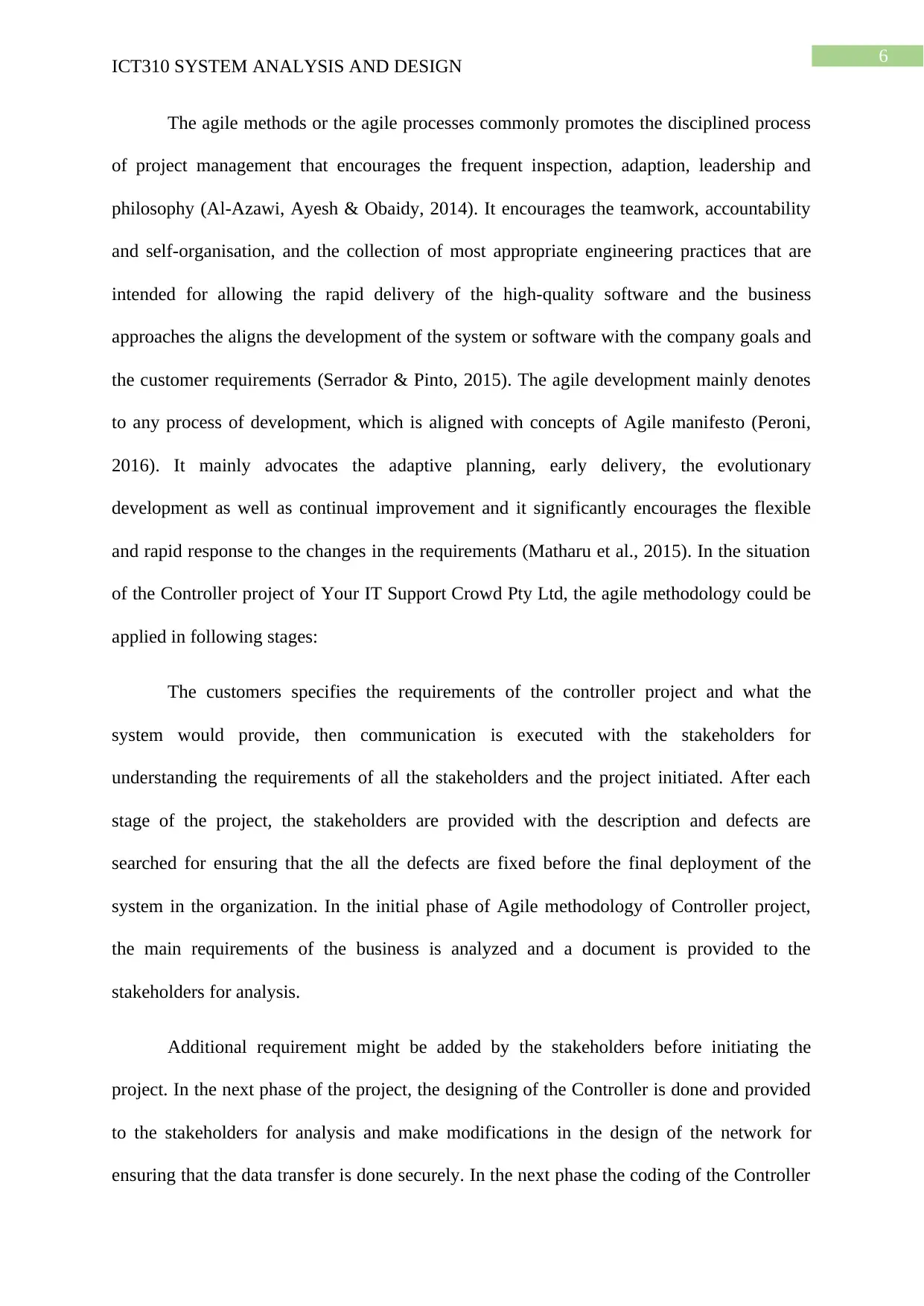
6
ICT310 SYSTEM ANALYSIS AND DESIGN
The agile methods or the agile processes commonly promotes the disciplined process
of project management that encourages the frequent inspection, adaption, leadership and
philosophy (Al-Azawi, Ayesh & Obaidy, 2014). It encourages the teamwork, accountability
and self-organisation, and the collection of most appropriate engineering practices that are
intended for allowing the rapid delivery of the high-quality software and the business
approaches the aligns the development of the system or software with the company goals and
the customer requirements (Serrador & Pinto, 2015). The agile development mainly denotes
to any process of development, which is aligned with concepts of Agile manifesto (Peroni,
2016). It mainly advocates the adaptive planning, early delivery, the evolutionary
development as well as continual improvement and it significantly encourages the flexible
and rapid response to the changes in the requirements (Matharu et al., 2015). In the situation
of the Controller project of Your IT Support Crowd Pty Ltd, the agile methodology could be
applied in following stages:
The customers specifies the requirements of the controller project and what the
system would provide, then communication is executed with the stakeholders for
understanding the requirements of all the stakeholders and the project initiated. After each
stage of the project, the stakeholders are provided with the description and defects are
searched for ensuring that the all the defects are fixed before the final deployment of the
system in the organization. In the initial phase of Agile methodology of Controller project,
the main requirements of the business is analyzed and a document is provided to the
stakeholders for analysis.
Additional requirement might be added by the stakeholders before initiating the
project. In the next phase of the project, the designing of the Controller is done and provided
to the stakeholders for analysis and make modifications in the design of the network for
ensuring that the data transfer is done securely. In the next phase the coding of the Controller
ICT310 SYSTEM ANALYSIS AND DESIGN
The agile methods or the agile processes commonly promotes the disciplined process
of project management that encourages the frequent inspection, adaption, leadership and
philosophy (Al-Azawi, Ayesh & Obaidy, 2014). It encourages the teamwork, accountability
and self-organisation, and the collection of most appropriate engineering practices that are
intended for allowing the rapid delivery of the high-quality software and the business
approaches the aligns the development of the system or software with the company goals and
the customer requirements (Serrador & Pinto, 2015). The agile development mainly denotes
to any process of development, which is aligned with concepts of Agile manifesto (Peroni,
2016). It mainly advocates the adaptive planning, early delivery, the evolutionary
development as well as continual improvement and it significantly encourages the flexible
and rapid response to the changes in the requirements (Matharu et al., 2015). In the situation
of the Controller project of Your IT Support Crowd Pty Ltd, the agile methodology could be
applied in following stages:
The customers specifies the requirements of the controller project and what the
system would provide, then communication is executed with the stakeholders for
understanding the requirements of all the stakeholders and the project initiated. After each
stage of the project, the stakeholders are provided with the description and defects are
searched for ensuring that the all the defects are fixed before the final deployment of the
system in the organization. In the initial phase of Agile methodology of Controller project,
the main requirements of the business is analyzed and a document is provided to the
stakeholders for analysis.
Additional requirement might be added by the stakeholders before initiating the
project. In the next phase of the project, the designing of the Controller is done and provided
to the stakeholders for analysis and make modifications in the design of the network for
ensuring that the data transfer is done securely. In the next phase the coding of the Controller
Paraphrase This Document
Need a fresh take? Get an instant paraphrase of this document with our AI Paraphraser

7
ICT310 SYSTEM ANALYSIS AND DESIGN
project is done where the controller application, the server and the client are properly aligned
and implemented for ensuring seaming data transfer among the server and the client. A
document of this phase is created and provided to the stakeholders for gaining insights
regarding modifications that could be done in the setup. It would allow the developer team to
fix the problems identified by the stakeholders and make the required modifications in the
setup of the Controller project.
ICT310 SYSTEM ANALYSIS AND DESIGN
project is done where the controller application, the server and the client are properly aligned
and implemented for ensuring seaming data transfer among the server and the client. A
document of this phase is created and provided to the stakeholders for gaining insights
regarding modifications that could be done in the setup. It would allow the developer team to
fix the problems identified by the stakeholders and make the required modifications in the
setup of the Controller project.
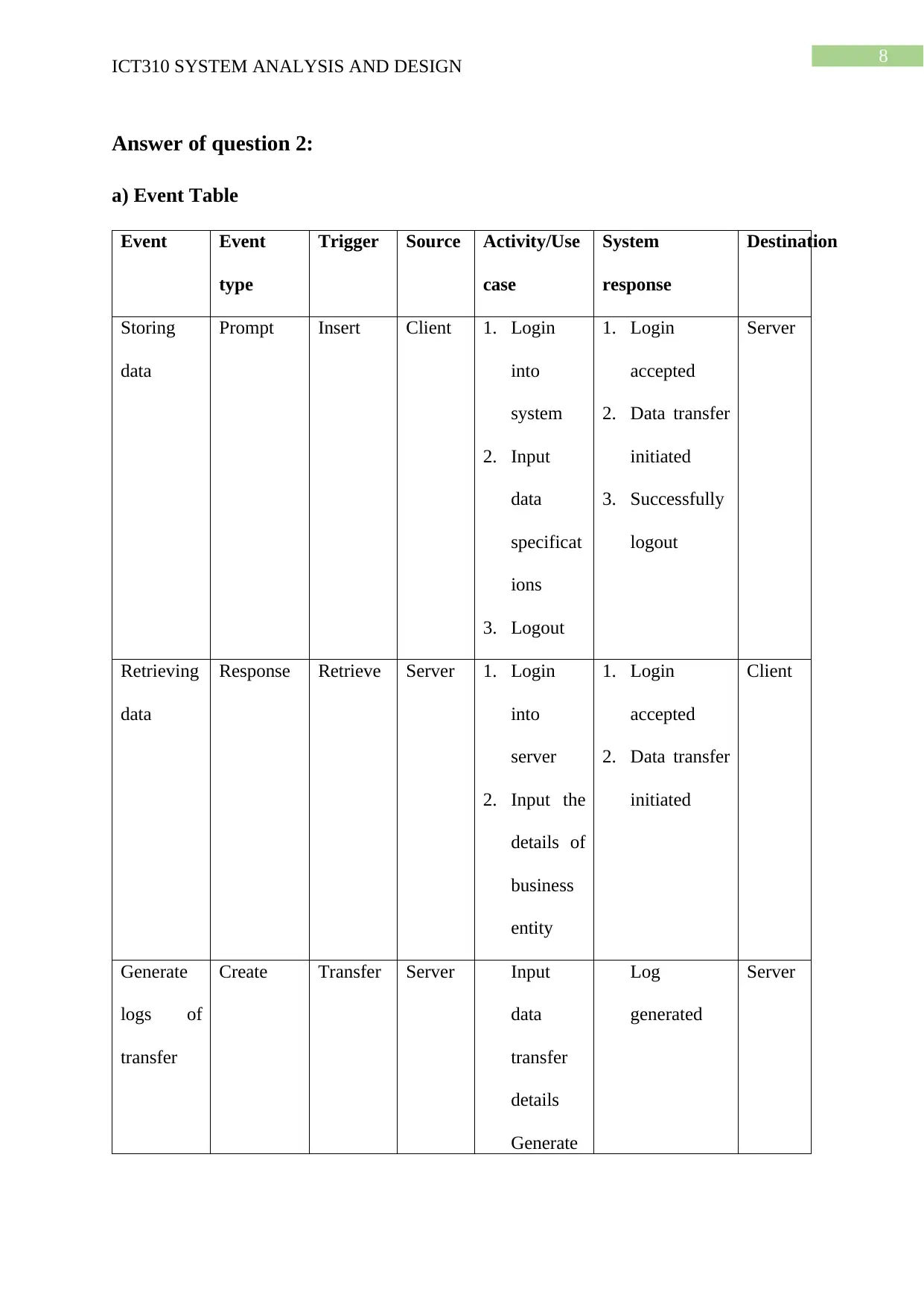
8
ICT310 SYSTEM ANALYSIS AND DESIGN
Answer of question 2:
a) Event Table
Event Event
type
Trigger Source Activity/Use
case
System
response
Destination
Storing
data
Prompt Insert Client 1. Login
into
system
2. Input
data
specificat
ions
3. Logout
1. Login
accepted
2. Data transfer
initiated
3. Successfully
logout
Server
Retrieving
data
Response Retrieve Server 1. Login
into
server
2. Input the
details of
business
entity
1. Login
accepted
2. Data transfer
initiated
Client
Generate
logs of
transfer
Create Transfer Server Input
data
transfer
details
Generate
Log
generated
Server
ICT310 SYSTEM ANALYSIS AND DESIGN
Answer of question 2:
a) Event Table
Event Event
type
Trigger Source Activity/Use
case
System
response
Destination
Storing
data
Prompt Insert Client 1. Login
into
system
2. Input
data
specificat
ions
3. Logout
1. Login
accepted
2. Data transfer
initiated
3. Successfully
logout
Server
Retrieving
data
Response Retrieve Server 1. Login
into
server
2. Input the
details of
business
entity
1. Login
accepted
2. Data transfer
initiated
Client
Generate
logs of
transfer
Create Transfer Server Input
data
transfer
details
Generate
Log
generated
Server
⊘ This is a preview!⊘
Do you want full access?
Subscribe today to unlock all pages.

Trusted by 1+ million students worldwide
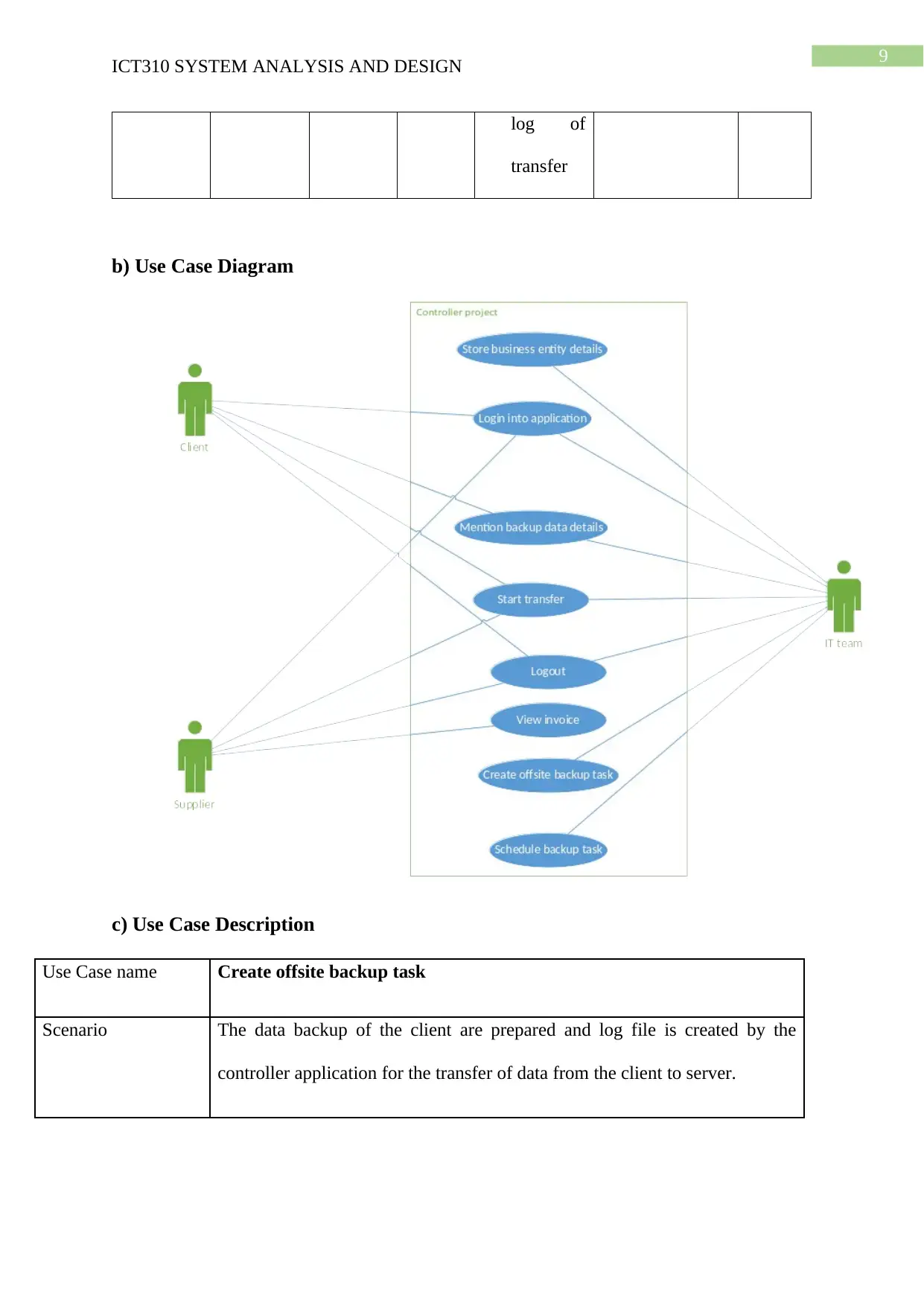
9
ICT310 SYSTEM ANALYSIS AND DESIGN
log of
transfer
b) Use Case Diagram
c) Use Case Description
Use Case name Create offsite backup task
Scenario The data backup of the client are prepared and log file is created by the
controller application for the transfer of data from the client to server.
ICT310 SYSTEM ANALYSIS AND DESIGN
log of
transfer
b) Use Case Diagram
c) Use Case Description
Use Case name Create offsite backup task
Scenario The data backup of the client are prepared and log file is created by the
controller application for the transfer of data from the client to server.
Paraphrase This Document
Need a fresh take? Get an instant paraphrase of this document with our AI Paraphraser
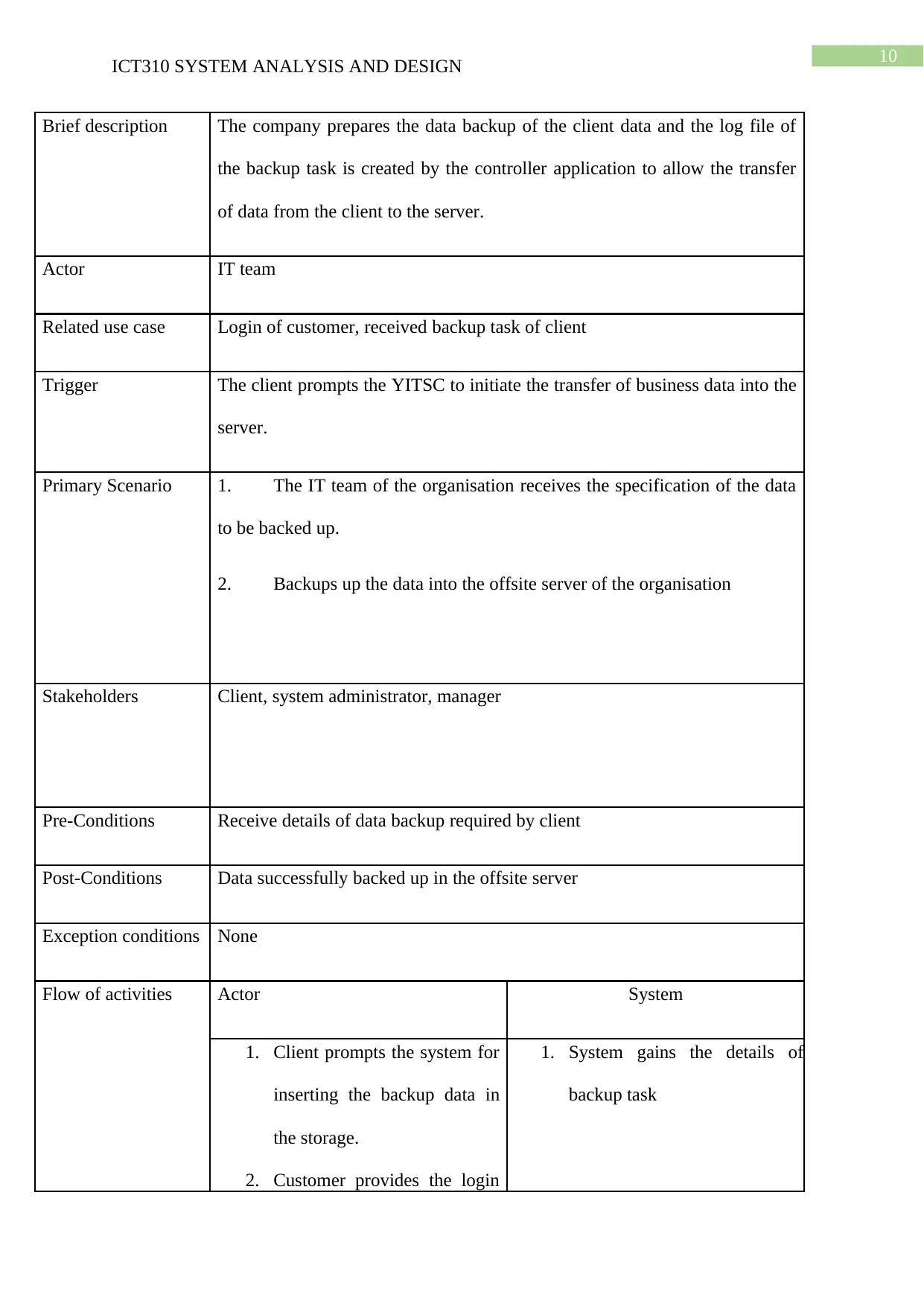
10
ICT310 SYSTEM ANALYSIS AND DESIGN
Brief description The company prepares the data backup of the client data and the log file of
the backup task is created by the controller application to allow the transfer
of data from the client to the server.
Actor IT team
Related use case Login of customer, received backup task of client
Trigger The client prompts the YITSC to initiate the transfer of business data into the
server.
Primary Scenario 1. The IT team of the organisation receives the specification of the data
to be backed up.
2. Backups up the data into the offsite server of the organisation
Stakeholders Client, system administrator, manager
Pre-Conditions Receive details of data backup required by client
Post-Conditions Data successfully backed up in the offsite server
Exception conditions None
Flow of activities Actor System
1. Client prompts the system for
inserting the backup data in
the storage.
2. Customer provides the login
1. System gains the details of
backup task
ICT310 SYSTEM ANALYSIS AND DESIGN
Brief description The company prepares the data backup of the client data and the log file of
the backup task is created by the controller application to allow the transfer
of data from the client to the server.
Actor IT team
Related use case Login of customer, received backup task of client
Trigger The client prompts the YITSC to initiate the transfer of business data into the
server.
Primary Scenario 1. The IT team of the organisation receives the specification of the data
to be backed up.
2. Backups up the data into the offsite server of the organisation
Stakeholders Client, system administrator, manager
Pre-Conditions Receive details of data backup required by client
Post-Conditions Data successfully backed up in the offsite server
Exception conditions None
Flow of activities Actor System
1. Client prompts the system for
inserting the backup data in
the storage.
2. Customer provides the login
1. System gains the details of
backup task

11
ICT310 SYSTEM ANALYSIS AND DESIGN
details in the system
3. IT team creates the backup
task details in the system
2. System verifies the account of
the user
3. System creates a log file of the
upload made in the storage
ICT310 SYSTEM ANALYSIS AND DESIGN
details in the system
3. IT team creates the backup
task details in the system
2. System verifies the account of
the user
3. System creates a log file of the
upload made in the storage
⊘ This is a preview!⊘
Do you want full access?
Subscribe today to unlock all pages.

Trusted by 1+ million students worldwide
1 out of 15
Related Documents
Your All-in-One AI-Powered Toolkit for Academic Success.
+13062052269
info@desklib.com
Available 24*7 on WhatsApp / Email
![[object Object]](/_next/static/media/star-bottom.7253800d.svg)
Unlock your academic potential
Copyright © 2020–2025 A2Z Services. All Rights Reserved. Developed and managed by ZUCOL.





